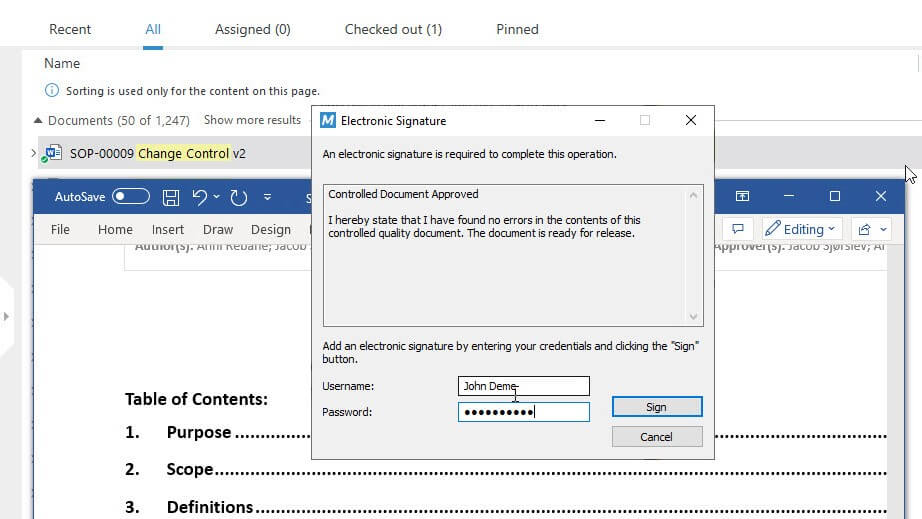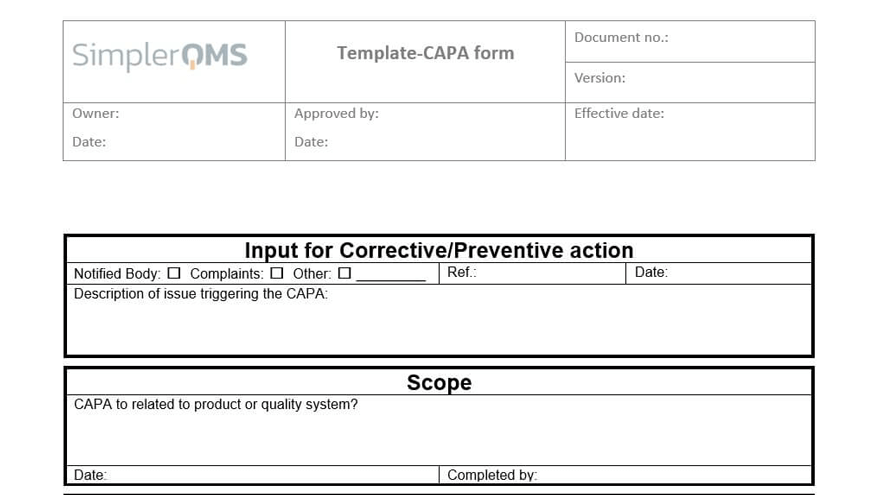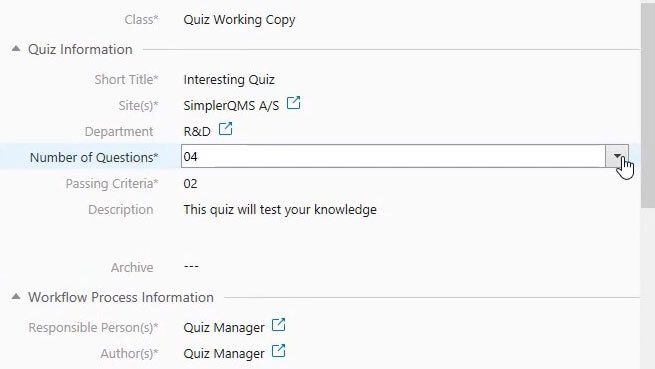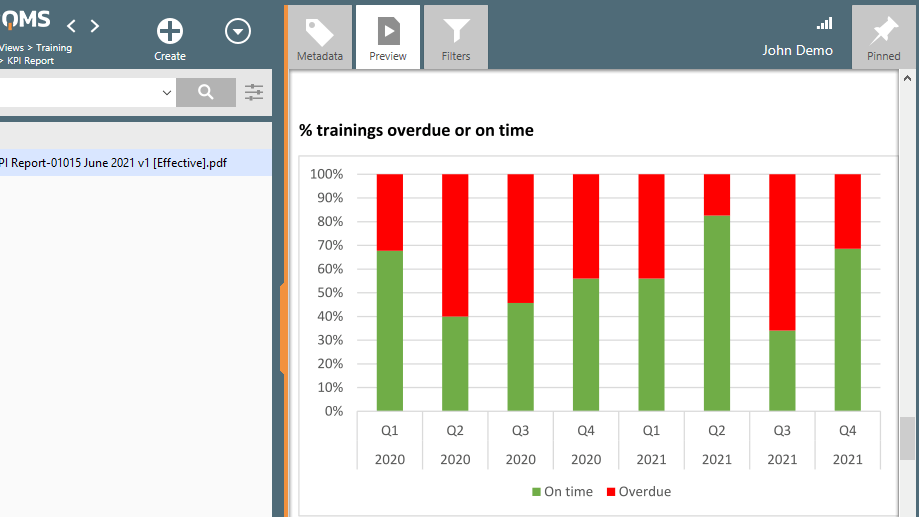The benefits of a Quality Management System (QMS) are numerous and wide-ranging. A QMS will help any industry streamline its processes and improve the overall quality of its products and services.
In the life sciences industry, a Quality Management System (QMS) is essential to ensure that products and services are safe, reliable, and compliant with industry standards.
Throughout this article, we will look at various benefits of a QMS, and how life sciences organizations can gain an edge by implementing a comprehensive Quality Management System. As well as further streamlining their processes with electronic QMS software.
SimplerQMS has helped dozens of life science companies transition to a modern electronic QMS system, helping them realize the benefits that come with it. If you are interested in optimizing your QMS and automating manual processes, feel free to book a personalized demo.
Let us now look at the 10 key benefits of having a QMS in place. But first, a brief overview of what a QMS is and what it entails.
Jump to any of the following topics:
- What is A Quality Management System (QMS)?
- 10 Biggest Benefits of a Quality Management System for Life Science Companies
- Streamline Your QMS With a Cloud-Based QMS Software
What is A Quality Management System (QMS)?
A Quality Management System (QMS) is a system within the organization that documents all policies, protocols, and controls that are essential for the creation and delivery of high-quality products and services to customers.
When you have an effective Quality Management System (QMS) in place, you will be continuously improving the quality of the products and services that your life sciences organization markets.
Another important reason why your life sciences organization must have a QMS in place is to ensure compliance with applicable requirements. Depending on the industry and the nature of the products and services delivered by your organization, you must have policies and procedures in place to ensure that all applicable requirements are met.
Various standards, regulations, and guidelines specify the requirements for quality management systems. Some of the main ones include:
- ISO 9001:2015 Quality Management Systems – Requirements. Specify the requirements for a quality management system within any organization, regardless of its type, size, or the products/services provided.
- ISO 13485:2016 Medical Devices – Quality Management Systems – Requirements for Regulatory Purposes. Specify the requirements for a quality management system where an organization needs to demonstrate its ability to provide medical devices and related services that will consistently meet customer and applicable regulatory requirements.
- US FDA 21 CFR Part 820 – Quality System Regulation. Sets forth current good manufacturing practice (cGMP) requirements. The requirements govern the methods, facilities, and controls used for the design, manufacture, packaging, labeling, storage, installation, and services of medical devices intended for human use.
- ICH Q10 Pharmaceutical Quality System – Scientific Guideline. These guidelines are intended to serve as a model for an effective quality management system. They apply to the development and manufacture of pharmaceutical drug substances and drug products, which include biotechnology and biological products.
Quality management systems can also be in one of three different formats:
- Physical (paper-based) system
- Hybrid QMS that contains both physical and software components
- Fully electronic (software-based) QMS
The main benefit of electronic QMS software as compared to paper-based or hybrid QMS is that there is no requirement for paper. All documentation is electronically stored and can be accessed from anywhere. This also means that manual processes can be automated, which increases efficiency and reduces the risk of human error.
The 10 Biggest Benefits of a Quality Management System for Life Science Companies
When your life science company has a structured, efficient smoothly-running quality management system in place, you accrue numerous benefits ranging from enhanced regulatory compliance and improved customer satisfaction, to saving precious resources like time and money.
Let us now look at the biggest benefits that you will stand to gain after implementing a Quality Management System (QMS). We will also see how an electronic quality management system helps advance these benefits even further.
Jump to the following sections to dive into more details:
- Augmented Regulatory Compliance
- Improved Customer Retention and Satisfaction
- Promoted Continuous Improvement
- Developed Operational Consistency
- Enhanced Internal Communications
- Streamlined Employee Training
- Increased Efficiency and Reduced Waste
- Improved Decision-Making
- Improved Company Culture
- Increased Profits
1. Augmented Regulatory Compliance
The life sciences industry is tightly regulated since its products and services directly affect the lives of countless patients. It is imperative that your products and services should be solely for their intended use, and safe and efficacious.
As per life science requirements, the organization is expected to have numerous QMS processes in place. Some of the main (but not all) quality management system processes that need to be in place are:
- Document control. The QMS should include procedures and protocols for the management and control of the documents and records that circulate within and outside your organization.
- Training management. It is essential that the organization has skilled and qualified personnel in specific job roles. This implies that training protocols are continuously evaluated, and training records maintained properly.
- Supplier management. Your organization’s QMS should have streamlined protocols in place for supplier management processes. This includes the selection, evaluation, approval of suppliers, continuous monitoring, and so on.
- Audit management. The QMS should have a procedure to ensure that internal and external audits are conducted as per the defined standards.
- CAPA management. Corrective and preventive actions (CAPA) may need to be implemented whenever there are instances of customer complaints, audit findings, nonconformances, or deviations. All these actions need to be properly documented, tracked and managed.
With such comprehensive QMS processes in place, your organization will have greater control over product quality. The organization’s ability to adhere to applicable requirements, and also detect and address any issues that may come up, will be improved.
Electronic QMS solutions such as SimplerQMS allow organizations to manage a wide range of quality processes in one unified platform.
SimplerQMS supports compliance with Life Science QMS requirements, streamlining:
- Document Control
- Training Management
- Supplier Management
- Audit Management
- Non-Conformance/Deviation Management
- CAPA Management
- And many other processes
2. Improved Customer Retention and Satisfaction
Customer retention and satisfaction are crucial to the success of any life sciences organization.
An important process in customer relations is customer complaint handling. The QMS should have protocols and procedures where customer feedback and complaints are meticulously documented.
The next step is to act on this information:
- Does it need to be escalated to a nonconformance?
- Should you implement a CAPA for a particular complaint?
Then, after CAPA is initiated and the nonconformance is resolved, the next steps could include issuing Change Requests, updating the concerned standard operating procedures (SOPs), and retraining relevant personnel. This way, the organization can ensure that similar issues do not arise again, and as a result, customer retention and satisfaction can be improved.
Digital QMS solutions like SimplerQMS, provide organizations with a suite of tools that also make it easier to document and manage customer complaints. For example, you can assign tasks and send notifications to concerned personnel, link customer complaints to NC, escalate them to CAPAs, track the effectiveness of corrective actions, and much more, all in one place.
Recommended Reading: Medical Device Complaint Handling: Processes and Best Practices
3. Promoted Continuous Improvement
The overarching principle for life science organizations is continuous improvement.
Clause 8.5 of ISO 13485:2016 mentions that the focus of medical device organizations should be continuous improvement. The company should identify and implement necessary changes for an effective quality management system, and the safety and performance of its products.
To give an example, imagine that your medical device company manufactures and markets artificial joints made of metal. Based on research, you realize that another material like ultra-high-molecular-weight polyethylene (UHMWPE) is a better choice for enhanced safety and performance, and decide to implement the change.
Since continuous improvement within the organization is an ongoing task, it can be a challenge to track and manage all the changes and processes. QMS software enables organizations to create, approve, track, and manage changes accordingly. Other features like automated notifications, task reminders, escalations, electronic signatures, and audit trails also help to streamline the overall process.

This way, you can ensure that all the necessary changes are implemented on time, thereby promoting continuous improvement.
4. Developed Operational Consistency
Being consistent is an important concept for any organization. Only when your operations are standardized, you can be sure of the quality of your products/services.
To build trust, establish awareness among your stakeholders, and market your products/services efficiently and profitably, you are required to be consistent. In its absence, the organization will likely fail.
When your organization has a well-organized and documented QMS that enunciates industry best practices, updated standard operating protocols, and well-defined checks and balances, you will be able to increase your operational consistency and reduce inefficiencies.
For instance, the formats for your records and documents must consistently follow the same formats throughout. This is possible with pre-defined document templates, forms (e.g. CAPA Forms, Nonconformance Report Templates, etc.), and procedures.
You can further enhance your operational consistency by utilizing an effective QMS software solution. Pre-configured workflows, document forms and templates, automated document routing, notifications, escalations, task reminders, and electronic signatures – all these features make it easier to maintain operational consistency and increase efficiency.

5. Enhanced Internal Communications
International QMS standards such as ISO 9001 emphasize the importance of internal communications in an organization. The quality management system should be so structured that emphasis is placed on internal communications.
ISO 9001:2015, clause 7.4 Communication, states that effective internal communications contribute to the success of an organization’s QMS. Conversely, many of the problems with a QMS can be traced back to poor communication.
The onus is on senior management to establish proper communication processes so that your employees can share information, provide feedback and give constructive criticism. In the absence of this two-way communication, your QMS will only be a set of documents.
For instance, an employee in the quality department may realize a better way of making an important component. When internal communication channels are open, and senior management will consider the feedback provided, the organization can identify new opportunities, improve processes, and thus make the QMS a success.
Furthermore, the organization may have other initiatives where employees would participate in co-authoring relevant documents and protocols, providing valuable input in the decision-making process.
Once again, QMS software can be of immense help to facilitate the communication process.
Cloud-based eQMS solutions like SimplerQMS make it easier to access documents and resources, communicate online, share insights, and collaborate effectively, practically from anywhere.
Moreover, pre-defined workflows, user access control, visibility into the progress of tasks and activities, real-time notifications, co-authoring, and escalations make it easy to track and manage communication throughout the organization.
6. Streamlined Employee Training
The biggest assets of an organization are its skilled workforce. For any organization to be successful, it must not only get the best talent but also retain this talent.
One way to achieve this is to provide employees with the right training and support.
For instance, when the organization is expanding and onboarding new employees it is essential that these new employees go through a structured training program and understand the internal processes and protocols.
Existing employees must also go through periodic training to keep their skills up-to-date. When introducing new technologies, processes, and procedures, the organization must make sure that employees are trained and updated on the same.
Every aspect of the training also must be well documented and tracked.
An efficient QMS enables this process by documenting all the training records, tracking the progress of employees, and monitoring their performance.
Moreover, you can use the QMS software with in-built training management capabilities to automate many of these processes, thus streamlining the employee training management process.
For instance, with automated document routing and electronic signatures, it is much easier to track the progress of employee training and record training completion. You can also ensure that the employees have understood the training material through customizable quizzes and pre-defined passing criteria.

7. Increased Efficiency and Reduced Waste
When your organization has a well-structured QMS, the various processes and tasks necessary for the production of your products or services will become more consistent. When these processes and tasks are streamlined, efficiency increases and wastage is reduced.
For instance, when you have standardized processes and procedures in place (or SOPs), it becomes easier to identify and eliminate any inefficiency or duplication of efforts.
When the organization has visibility into all the tasks and processes involved in producing a product or service, it is easier to identify any bottlenecks or redundant activities that can be eliminated. This also opens the possibility to identify areas where resources can be reallocated and better utilized, thus reducing operational costs.
Leading to the final example which could be that as an organization you may choose to concentrate on your core competencies and outsource some of the other activities to outside vendors. This will not only help you reduce costs but also optimize the process by utilizing the expertise of outside vendors.
8. Improved Decision-Making
We would all love to take excellent decisions both in our personal lives and as part of an organization. This is possible using the model of evidence-based decision-making.
This means that you gather the required information in the form of data and market feedback, and then make decisions.
QMS standards highlight the importance of management review of the organization’s QMS. For instance, Section 9.3 of ISO 9001:2015 and Section 5.6 of ISO 13485:2016 both highlight management review.
Senior management should regularly review the QMS and ensure its suitability, adequacy, and effectiveness. This will enhance the decision-making capabilities of the organization.
The data collected through the various processes and procedures must be analyzed, documented, and presented to senior management to make informed decisions.
QMS software can help in the process through capabilities that enable the organization to quickly analyze the data, draw meaningful insights, and present the same to the relevant stakeholders for review.
For example, with SimplerQMS you can easily monitor the status of each activity or task, export the data for further analysis as well as generate KPI reports on-demand to track performance.

This will help senior management make better decisions that are data-driven and in line with the organizational goals.
9. Improved Company Culture
The ethos of the organization should be quality. When you are driven by quality, it becomes everyone’s business.
This starts with the senior management who must be committed to quality. They will define the principles of quality, which will then percolate to all departments of the organization. This results in employees being aligned and trained in the principles of quality management.
This culture within the organization is routed through the QMS.
A robust QMS will foster quality at all levels through its policies, processes, and procedures.
When the organization and its employees are clear about quality, this message gets carried to other stakeholders. Suppliers, end-users, and other partners in the industry will become aware that your organization pays a lot of attention to quality.
10. Increased Profits
When your organization has implemented a robust quality management system, it can also help in boosting profits.
The aspects that influence it are increased efficiency and reduced wastage, lowering of operational and administrative costs, satisfied customers, increased market share, as well as an increased possibility to access new markets. All these together help the organization to grow its profits.
QMS software in particular can cut costs related to the manual processes in your QMS. This will enable staff to focus on other areas of improvement and not get bogged down by mundane tasks like chasing signatures for document approvals, finding the right documents and version control, compiling reports, and so on.
Streamline Your QMS With a Cloud-Based QMS Software
There are numerous benefits when your life sciences organization has a quality management system. These benefits range from regulatory compliance to customer satisfaction and increased profits.
The prevailing notion in your organization may be:
“We have a robust QMS in place, and nothing more needs to be done”.
But you are in a life science industry where the keyword is innovation. Not only should you improve your existing portfolio of products and services, but you also need to bring in new technologies to stay ahead of your competitors.
This means that your robust QMS can be further streamlined by going one step ahead and implementing one of the best QMS software solutions available in the market.
SimplerQMS provides QMS software that is designed specifically for life sciences organizations. We help life sciences companies streamline their quality management processes, right from document control to change management, audit management, complaint handling, and many other processes.
Quality management systems have traditionally been implemented using manual paper-based or hybrid systems. Such a system format may make sense for very small companies with available human resources to get the work done.
However, as the company grows, these traditional systems have their inherent challenges and inefficiencies:
- Lack of storage space. Paper-based documents and records need a lot of space. Additionally, you should keep these documents in an accessible location. Many eQMS software solutions come with cloud-based storage, where documents and records are stored in secure cloud servers and can be accessed across the globe.
- Security issues. Paper-based documents and records can get damaged, stolen, lost, or misplaced. With an eQMS, your documents and records are stored in secure servers and are only accessible by authorized personnel with appropriate access rights.
- Human errors. Humans are prone to errors. Important documents may be circulated without proper sign-offs, or documents may get misplaced. An eQMS system can help to reduce errors by automating certain processes for effective control and management.
- Costs. Paper-based document and record systems come with plenty of costs. Papers, printing, storage, and so on are all costly. Also, we need to factor in the environmental costs of tons of paper, ink, and so on. With eQMS solutions, these costs are nullified.
Investing in a cloud-based QMS software solution can reap many benefits for your organization. It can help you further streamline operations, save costs, and increase profits.
However, it is not an easy decision to make as it involves a huge investment. Therefore, we recommend you download our free eQMS Business Case templates to understand the various benefits and costs associated with investing in an eQMS system. These templates can help you identify the true value of investing in an eQMS system, and present a case to your stakeholders and teams.
Final Thoughts
Quality Management Systems are an integral part of any organization. This is especially true of the life sciences industry where your products and services directly or indirectly affect the lives of so many people.
Quality should be the benchmark by which every organization in this industry should be known. With quality at the forefront, you will demonstrate to your stakeholders that your products and services are safe, efficacious, and solely for their intended purpose.
This is possible when you have a robust quality management system in place. With such a system, you will accrue many benefits which we discussed in this article.
Traditionally, manual paper-based or hybrid documentation systems have been used by organizations. In a continually evolving environment, such systems bring in their challenges and inefficiencies.
QMS software solutions, including SimplerQMS, have been developed to streamline and automate quality processes. Such a system can help your organization reduce costs, increase efficiency and profits, and make sure that you stay on top of your compliance requirements.
If you are interested in learning more about SimplerQMS, and how it could help your life science organization, you can book a personalized demo and talk with one of our Quality Solution experts.